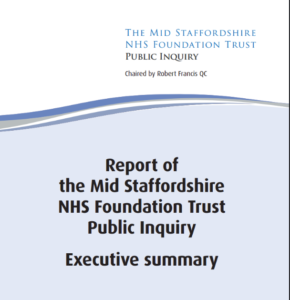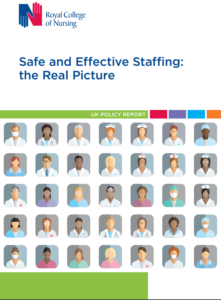This week’s blog is by Catherine Best (@CBest_23) and Parveen Ali (@parveenazamali) from Sigma (SigmaTheta Tau International Honor Society of Nursing, @sigmanursing).
Contemporary nursing issues within the UK herald the need for staffing for safe and effective care (RCN, 2017). This requires the correct number of nurses, with the right level of skill, to be available in the right place and at the right time (RCN, 2017). With unprecedented levels of nursing shortages apparent across the globe, this is not a call for UK nurses alone to take action, but all nurses anywhere in the world, across all specialities, in all clinical and non-clinical areas where care is delivered by nurses.
Safe staffing has been a key feature of nursing research since the work undertaken by Harris, et al. (1953); each proceeding decade nurturing a plethora of further research that tells of the impact of inadequate staffing levels (Moores and Moult, 1979; Murphy, 1986; Waters,1999; Flynn and McKeown, 2009; Aiken 2018, Aiken et al., 2018). Moreover, there is evidence that when there are too few nurses available, care costs rise due to increased expenditure associated with patients acquiring for example, a healthcare-associated infection (Aiken and Fagin, 2018).
Healthcare Failings
The importance of safe staffing gained considerable momentum in the UK following the Francis Report (Francis, 2013), which highlighted the serious shortcomings at the Mid Staffordshire NHS Foundation Trust and its failure to provide safe and effective care; the failings being identified as disastrous (NHS, 2013).
This report further highlighted the significant impact on patient care when there is a failure to listen to the opinions of nurses, patients and carers; and determined that within the NHS safe nurse staffing levels should become a priority. Despite the increasing body of evidence however, which supports the need for safe staffing levels, nurses continue to be angered by continued failings to ensure optimal staffing (Unison, 2017); the debate at times appearing to stagnate (RCN, 2017).
Despite these failings, it is apparent that the safe staffing agenda is gaining considerable momentum as demonstrated by the recent position statement of the International Council for Nurses (Aiken and Fagin, 2018), which recognises the rigorous global research now available and authenticates the correlation between nurses caring for fewer patients and better outcomes for those hospitalised, providing a global agenda for action.
In their 2017 report ‘Safe and Effective Staffing: The Real Picture’ the Royal College of Nursing stated that there were more than 40,000 vacant registered nursing posts in the NHS in England (RCN, 2017). Today, this is calculated at over 43,000 (RCN, 2019).
A plethora of reasons exist, including the changes made to the nursing bursaries in England (Department of Health and Social Care, 2017) and combined with the decline in the population of 18-year olds, there has been a fall in the number of nursing students, rather than the anticipated rise (Buchan et al., 2017). Furthermore, with one in three nurses working in the NHS due to retire within 10 years and the continued challenges to International recruitment (RCN, 2017a) these phenomena have created a sinkhole of immense proportions. Disappointingly these are not the only problems facing the UK (Lawless et al., 2019; Cho et al., 2016; Simpson et al., 2016, Simpson, 2017). Multiple references have also been made of the challenges faced to service delivery as a result of Brexit (Burdett and Fenge, 2018; Dayan, 2018; Read and Fenge, 2019) as well as the iatrogenic incidents that occur within healthcare delivery, with several systematic reviews having examined this phenomenon (Panagioti et al., 2017).
Conclusion
Ensuring safe staffing is complex and requires a multifaceted approach in which a plethora of influences must be considered, including the practice setting, patient need, and level of skill (NMC, 2016); inferring perhaps that safe staffing is fluid and requires considerable thought.
In order for safe staffing to be embedded across the whole of the UK, across all sectors of healthcare delivery, nurses working on the frontline, must work collaboratively and challenge the status quo (Chinn and Kramer, 2018).
By understanding the problem from personal viewpoints, nurses are then able to act with the intention to improve the situation [and those of others], share experiences, and develop actions, insights and knowledge about the situation and what is required to facilitate positive change (Chinn and Kramer, 2018).
In contemporary society there is a recognition that nurses can make a unique contribution to improving health, promoting gender equality and supporting economic growth (APPG, 2016). This is supported by McCollum et al. (2017) who argue that nurses promote a culture of health, well beyond the expectations of their everyday working lives. Nurses therefore are in a strong position to facilitate change that not only improves patient care, but also improves the health and wellbeing of nurses. As a profession nurses have the knowledge and the ability to critically reflect and act to ensure safe staffing levels become a priority within healthcare.
In December 2019, Boris Johnson the newly elected UK Prime Minister, affirmed his support for the nursing profession by declaring that all student nurses will be guaranteed additional financial assistance of at least £5,000 a year to support with living costs (Department of Health and Social Care, 2019). This victory is testament to the courage of nurses, their successful campaigning and their willingness to take collective action.
Despite this victory however, there remains a much bigger issue; that of reinstating the nursing bursary. This achievement may still be some way off, but at least for now, there is hope that the situation can be different.
References
Aiken, L.H. Sloane, D.M. Ball, J. Bruyneel, L. Rafferty, A. and Griffiths, P. (2018) Patient satisfaction with hospital care and nurses in England: an observational study. British Medical Journal Open, 8(1), 1-8.
Aiken, L. (2018) No doubt that there’s safety in nurse numbers. Nursing Standard, 32(21), pp. 29.
Aiken, L. and Fagin, C. (2018) Evidence‐based Nurse Staffing: ICN’s New Position Statement. International Nursing Review, 65(4), pp. 469-471.
All Party Parliamentary Group (2016) Triple Impact. How developing nursing will improve health, promote gender equality and support economic growth. London: APPG.
Buchan, J. Charlesworth, A. Gershlick, G and Seccombe, I. (2017) Rising pressure: the NHS workforce challenge. Workforce profile and trends of the NHS in England. London: The Health Foundation.
Burdett, T. and Fenge, L.A. (2018) Brexit: the impact on health and social care and the role of community nurses. Journal of Community Nursing, 32(4), pp.62-65.
Chinn, P.L. and Kramer, M.A. (2018) Knowledge Development in Nursing. Theory and process. 10th ed. St Louis, MO: Elsevier.
Cho, S.H. Lee, J.Y. June, K.J. Hong, K.J,. and Kim, Y. (2016) Nurse staffing levels and proportion of hospitals and clinics meeting the legal standard for nurse staffing for 1996~2013. Journal of Korean Academy of Nursing Administration, 22(3), pp. 209-219.
Dayan, M. (2018) Long division: summing up Brexit and the NHS. British Medical Journal, 360, k1320.
Department of Health and Social Care (2019) Nursing students to receive £5,000 payment a year [Online] Available from:
https://www.gov.uk/government/news/nursing-students-to-receive-5-000-payment-a-year [Accessed 20 December 2019].
Flynn, M and McKeown, M. (2009) Nurse staffing levels revisited: a consideration of key issues in nurse staffing levels and skill mix research. Journal of Nursing Management, 17(6), pp. 759-66.
Francis R. (2013) Report of the Mid Staffordshire NHS Foundation Trust Public Inquiry. London: The Stationery Office.
Harris, L. McCaleb, I. Nobles, G.G. and Powell, F.L. (1953) Married nurses and hospital staffing. American Journal of Nursing, 53(4), pp.438-439.
Department of Health and Social Security (2017) Policy paper NHS bursary reform Gov.UK. [Online] Available from: https://www.gov.uk/government/publications/nhs-bursary-reform/nhs-bursary-reform [Accessed 17 May 2019].
Lawless, J. Couch, R. Griffiths, P. Burton, C. and Ball, J. (2019) Towards safe nurse staffing in England’s National Health Service: progress and pitfalls of policy evolution. Health Policy, 123(6), pp. 590-594.
McCollum, M. Kovner, C.T. Ojemeni, M.T. Brewer, C and Cohen, S. (2017) Policy, Politics and Nursing Practice, 18(1), pp.7-16.
Moores, B. and Moult, A. (1979) The relationship between the level of nurse staffing and the patterns of patient care and staff activity. Journal of Advanced Nursing, 4, pp.299-306.
Murphy, M.Z. (1989) Survival tactics for short-staffed units. RN, pp.61-64.
National Health Service (2013) Mid Staffs inquiry calls care failings a ‘disaster’. [Online] Available from: https://www.nhs.uk/news/medical-practice/mid-staffs-inquiry-calls-care-failings-a-disaster/ [Accessed 17 May 2019].
Nursing and Midwifery Council (2016) NMC Briefing: Appropriate staffing in health and care settings. London: NMC.
Panagioti, M. Khan, K. Keers, R. Abuzour, A. Phipps, D. Bower, P. Avery, T. and Ashcroft, D. (2017) Preventable Patient Harm across Health Care Services: A Systematic Review and Meta-analysis (Understanding Harmful Care). A report for the General Medical Council.
Read, R. and Fenge, L.A. (2019) What does Brexit mean for the UK social care workforce? Perspectives from the recruitment and retention frontline. Health and Social Care in the Community, 27(3), pp.676-682.
Royal College of Nursing (2019) Standing up for Patient and Public Safety. London: RCN.
Royal College of Nursing (2017) Safe and Effective Staffing: The Real Picture. London: RCN.
Royal College of Nursing (2017a). Safe and Effective Staffing: Nursing Against the Odds. London: RCN.
Simpson, K.R. (2017) Safe nurse staffing is more than numbers and ratios. The American Journal of Maternal/Child Nursing, 42(5), pp.304.
Simpson, K.R. Lyndon, A. and Ruhl, C. (2016) Consequences of inadequate staffing include missed care, potential failure to rescue, and job stress and dissatisfaction.
Journal of Obstetric, Gynecologic and Neonatal Nursing, 45(4), pp.481-490.
UNISON (2017) Ratios not rationing. UNISON safe staffing report 2017. London: UNISON.
Waters, S. (1999) A matter of Life and Death. Nursing Standard, 13(41), pp.12-13.




